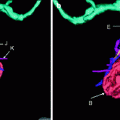Randy Ray RichardsonAtlas of Pediatric Cardiac CTA2013Congenital Heart Disease10.1007/978-1-4614-0088-2_1© Springer Science+Business Media New York 2013
1. Advantages of Cardiac CTA over Other Imaging Modalities
(1)
Department of Radiology, St. Joseph’s Hospital and Medical Center, Creighton University School of Medicine, West Thomas Rd 350, 85013 Phoenix, AZ, USA
(2)
Children’s Heart Center, Phoenix Children’s Hospital, Phoenix, AZ, USA
Abstract
Congenital heart imaging has changed dramatically over the past several decades. In previous decades, plain x-ray films were a key diagnostic test, with the use of angiocardiography to make specific preoperative diagnoses. However, with several robust cross-sectional imaging modalities now available, this method no longer is the standard. Although plain films still are often obtained, they serve as more of a screening tool, with the first line of imaging being echocardiography. Echocardiography typically does not require sedation and does not expose the patient to ionizing radiation. Echocardiography provides detailed intracardiac anatomy with real-time functional evaluation; however, it may be limited for evaluating extracardiac structure. Similarly, cardiac MRI does not expose the patient to ionizing radiation and offers some of the best tools for functional evaluation of the heart. Cardiac CT angiography (CTA) is another cross-sectional imaging modality that may be used for anatomic and functional evaluation in patients with congenital heart disease. Cardiac CTA does require ionizing radiation; however, with new techniques designed to minimize the patient’s exposure, the radiation can be kept within safe parameters and the advantages of CT may be used.
Stay updated, free articles. Join our Telegram channel

Full access? Get Clinical Tree








